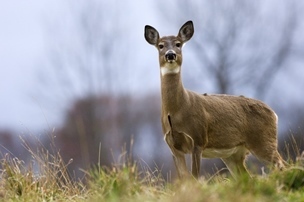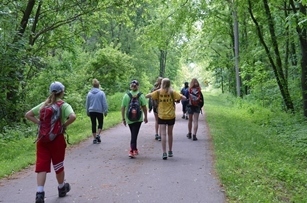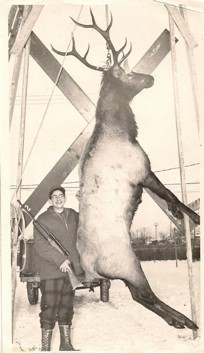|
|
|
|
 News Digest - Week of April 9, 2018
|
|
|

|
 More than 4,000 adult trout – fish that had been used for breeding at our state hatcheries – recently were stocked in the Clinton River (Auburn Hills, Rochester Hills), the Huron River (Proud Lake Recreation Area) and the Spring Mill Pond (Island Lake Recreation Area), making southeast Michigan a great destination for spring fishing.
The Clinton River was stocked with 800 rainbow trout and 650 brown trout, all upstream of Yates Dam; the Huron River took 1,600 brown trout and 1,200 rainbow trout, all ranging in size from 11 to 22 inches; and 400 brown trout and 400 brown trout between 14 and 22 inches now call the Spring Mill Pond home.
Before you hit the water to target these trout, remember that special regulations apply. The Huron River at Proud Lake Recreation Area is limited to flies only, catch-and-release fishing and Spring Mill Pond at Island Lake Recreation Area is limited to artificial lures only, catch-and-release fishing, both from April 1 through April 27. Starting April 28, all baits are allowed on both waters and anglers may keep up to five trout over 8 inches, but just three that measure over 15 inches.
For additional details, see the 2018 Michigan Fishing Guide at michigan.gov/dnrdigests or contact Jeff Braunscheidel, 248-666-7445 or Sara Thomas, 248-666-7443.
|
 Since the state's first confirmation in May 2015 of chronic wasting disease in a free-ranging, white-tailed deer, a total of 57 deer in Clinton, Ingham, Ionia, Kent, Mecosta and Montcalm counties have tested positive for CWD. The DNR has taken swift action, guided by Michigan's comprehensive CWD surveillance and response plan.
Hunters and residents interested in learning more about CWD or who want to share their observations about it are encouraged to attend upcoming public engagement meetings in Bay City, Cadillac, Detroit, DeWitt, Gaylord, Houghton, Iron Mountain, Kalamazoo, Marquette, Newberry and Rockford. Those who can't make a meeting can join in a web-based opportunity, starting April 10. More information on chronic wasting disease, the meetings and the web option is available at michigan.gov/cwd.
|
 Eastern phoebes, tree swallows, yellow-rumped warblers, piping plovers and many other birds may soon be in your sightline! Springtime in Michigan offers plenty of opportunities to watch for migrating birds, as long-distance migrants are poised to return in May from their winter locations in the southern United States.
Caleb Putnam, Michigan’s bird conservation coordinator with the Michigan DNR and Audubon Great Lakes, said our state’s plentiful Great Lakes shoreline makes it even easier to spot birds because they tend to concentrate along shore areas. Michigan also stands at a key migration point for ducks heading for the Great Plains and Hudson Bay.
"In addition, Michigan’s well-managed public lands – in state parks, state game areas and state forests, for example – provide excellent wetlands, forests and grasslands that are used by both game and nongame species, and managed for both by the DNR's highly knowledgeable biologists and foresters,” Putnam said.
These feathered friends are a big draw, too. Putnam pointed to the U.S. Fish and Wildlife Service’s 2011 report, “Birding in the United States: A Demographic and Economic Analysis," which ranked Michigan as the nation’s 18th most avid state, based on days per year spent birding.
Want to try to spy some birds even earlier? Check out upcoming tours starting at 9 a.m. Saturday, April 14, at three of Michigan’s Wetland Wonders locations:
- Muskegon County Wastewater System. Meet at the Muskegon State Game Area office, 7600 E. Messinger Road, Twin Lake, 231-788-5055.
- Pointe Mouillee State Game Area, 37025 Mouillee Road, Rockwood, 734-379-9692.
- Nayanquing Point State Wildlife Area, 1570 Tower Beach Road, Pinconning, 989-697-5101.
Get more information on these and other birding tours on the DNR website or by contacting Holly Vaughn at 313-396-6863. Learn more about birding and birds in general at the MI Birds Facebook page.
|
 More than 25,000! That’s how many miles that Scouts in Michigan have hiked during the first three Iron Belle Challenge events in 2015, 2016 and 2017. The Department of Natural Resources is asking Cub Scouts, Boy Scouts and Girl Scouts across the state to lace up their boots, grab their water bottles, and hit the trails to drive that number even higher for this year’s challenge June 2 (which happens to be National Trails Day).
Michgan’s Iron Belle Trail, stretching from Belle Isle in Detroit all the way to Ironwood in the Upper Peninsula’s western end, links many other trails, communities, parks and forests along its 1,221-mile hiking and 798-mile bicycling routes. That means plenty of opportunities for Scouting troops statewide to join in the outdoor fun.
“We’ve seen great Iron Belle Challenge participation from the start, with Scouts hiking the trail all over the state, in Detroit, Battle Creek, Cheboygan, Marquette, Ironwood and many other places,” said Ray Rustem, a youth programs specialist with the DNR. This year, Rustem said Scouts can choose not just to hike, but also can participate via water trails, equestrian trails, ORV trails – the choice of trail and method of travel is up to them.
All Scouting participants will receive commemorative patches. For an even bigger challenge, participants are invited to return to the trail Sept. 29, National Public Lands Day, to complete a stewardship activity and earn a special rocker for the patch.
Want more details? Visit michigan.gov/dnrscouting or contact Ray Rustem, 517-284-6070. Learn more about the Iron Belle Trail (including an interactive map) at michigan.gov/ironbelle.
|
 It’s not often a 100-year milestone can be celebrated, but 2018 marks one of those times for Michigan wildlife. After unregulated hunting and a drastically changing landscape decimated the state’s elk population by the late 1800s, several individuals and natural resources groups worked to right that situation.
Today's elk herd dates back to 1918, when seven elk brought from western states were released near Wolverine in Cheyboygan County, Michigan. Learn more about that story in this brief video. From that reintroduction, numbers steadily climbed and reached the point where limited hunting was offered in 1964 and 1965.
Canton resident Bob Preville was just 15 years old when he took down a wild Michigan elk on a snowy December day in 1964.
“It’s just something you never forget,” said Preville, who at the time lived in Detroit and hunted with his grandfather John Gumbetter, owner of Gumbetter Sporting Goods in Troy. “We scouted during deer season that year. I was the only one of our group of four who drew a tag! My grandpa and I saw tracks in the snow on public land near Tin Shanty Road, and I took a 5x4 bull the evening of the first day.”
Gary Cole of Dearborn captured elk in a different way – with acrylic paints – and won the DNR’s poster contest commemorating the centennial anniversary of elk’s reintroduction. (Posters are available at DNR offices; call first to ensure availability.) Cole is a self-taught wildlife artist who has hunted elk in the western U.S. and now hunts deer in the Upper Peninsula.
Elevating elk further, a wildlife habitat license plate featuring Michigan elk is available through the Secretary of State’s office. Plate sales help support the state’s nongame fish and wildlife habitat.
Learn more about these resources and opportunities at michigan.gov/elk or call Katie Keen at 989-385-0336.
|
 DNR customer service centers and field offices in Michigan’s northern Lower and Upper peninsulas report they’re starting to receive phone calls about nuisance bears. According to wildlife biologists, habits in wild animals can’t be reversed so it’s wise to not let them start in the first place. Bears that find quick, calorie-rich meals (like bird seed) on decks and in backyards tend to return to those spots. Food rewards are the best way to train animals to make repeated visits, invited or not – so it’s best to remove food sources like bird feeders.
Michigan is home to 12,000-plus bears – over 2,000 in the northern Lower Peninsula alone. Bears are omnivores, meaning they’ll eat plants and animals and have no trouble finding natural food such as fruit, nuts, roots and insects. Bears are smart, so be smarter. Help your community and keep bears at a distance by removing bird feeders. Get more tips from the DNR’s “Bear Essentials” video or contact Katie Keen at 989-385-0336.
|
PHOTOS AVAILABLE: News editors interested in photos to accompany these stories can get them in this photo folder. Caption details also are available there.
|
|
|
|
|
|
|
MANAGE SUBSCRIPTIONS | UNSUBSCRIBE ALL | CONTACT US | FEEDBACK | HELP
|
|
|